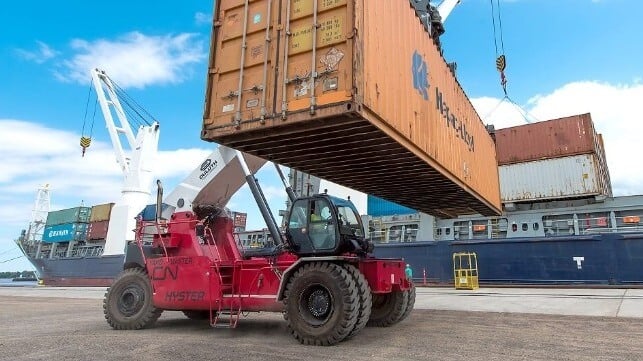Expanding Container Shipping Along the Great Lakes and Seaway

The rise in fuel prices has prompted renewed interest in expanding container shipping at America’s Great Lakes ports, like Duluth and Cleveland. There is potential for Port of Duluth to develop containerized dry bulk agricultural exports to Europe, where growing numbers of customers are willing to take delivery of containers of agricultural produce.
Introduction
The Port of Cleveland played an instrumental role in developing viable container shipping between Europe and the Great Lakes when it introduced a direct service to Antwerp. A comparatively small container ship of under 1,000 TEU has feasibly carried containers between Antwerp and Cleveland, with rates that compete with the alternative option - a mega-size container ship sailing to Port of Newark followed by high-cost railway connection to Cleveland. The Port of Duluth involves an even greater railway distance (1250 miles), making direct Duluth – Europe container shipping potentially more attractive.
The Port of Hamilton on Lake Ontario took the initiative to develop a maritime container connection to the Port of Montreal, with future potential to expand to include a future interline connection to the Port of Halifax. There is potential for a viable Europe – Halifax – Hamilton connection courtesy of terms negotiated in the Canada – Europe Trade Agreement (CETA) that makes provision for container transshipment at Port of Halifax.
Port of Duluth
The precedent of the Antwerp – Cleveland container shipping service provides an economic basis and business case to extend the service to Port of Duluth, located in the western region of Lake Superior. Duluth’s metro population of 290,000 is located within close proximity to the Minneapolis – St. Paul metropolitan area, with a population of almost 3.7 million. Nearby Winnipeg, Canada is home to another 825,000. The Port of Duluth can serve a population of over 10-million that would include the states of North and South Dakota, Minnesota, Wisconsin, Iowa, Nebraska and the Canadian provinces of Manitoba and Saskatchewan.
While ports around the Great Lakes represent destinations for containers that originate from overseas, there is a need to develop an export market involving empty containers that arrived with import items near Great Lakes and Seaway ports. An initiative involving the transportation of dry bulk in containers has been tested along sections of the American inland waterway system, involving tugs and barge tows. Agricultural dry bulk includes wheat, barley, oats, soy, peas, beans and corn with non-agricultural dry bulk including salt and also of potash fertilizer that may be transported inside containers.
Containerized Dry Bulk Export
Agricultural dry bulk cultivated in regions that could be exported in containers via Port of Duluth include durum wheat, spring wheat, corn, soy, peas, beans, lentils, barley and oats. Main production areas would include North and South Dakota along with Saskatchewan and Manitoba in Canada. Saskatchewan is the world’s biggest exporter of peas, lentils, durum wheat and oats as well as being the world’s leading producer of potash that is used for fertilizer. Main highways and railway lines link Port of Duluth with important American and main Canadian agricultural regions that would benefit from containerized export of their produce.
European markets have indicated a willingness to accept delivery of containers of dry bulk agricultural produce. There is potential to connect Port of Duluth with European ports that would accept delivery of containerized dry bulk agricultural production. Railway trains would carry most of the containers of agricultural dry bulk from producing areas to Port of Duluth, for transfer to Seaway-max size container ships of up to 1,400 TEU capacity. The vessels on this route could take aboard additional containers of agricultural dry bulk at one of the ports along the St. Lawrence Seaway prior to sailing to Europe.
Conclusions
At the present time, the Port of Cleveland is the main destination on the Great Lakes for container ships that connect to Europe. The potential to transfer containerized agricultural dry bulk for export to overseas markets at Port of Duluth would significantly increase container shipping along the Seaway and across the Great lakes. While there might be the option to transfer containers between smaller vessels and mega-size container ships at Port of Halifax, the precedent between Ports of Cleveland and Antwerp has proven that a small container ship can feasibly sail between the Great Lakes and Europe.
European customers have become willing to take delivery of containerized agricultural dry bulk from North America. Such a shift in the market provides opportunity for Port of Duluth to develop agricultural dry bulk container shipping to Europe and make productive use of available empty containers. Such an operation would complement the export of agricultural dry bulk from the Port of Thunder Bay, where bulk carriers are often loaded to capacity before sailing to European destinations.
The opinions expressed herein are the author's and not necessarily those of The Maritime Executive.
